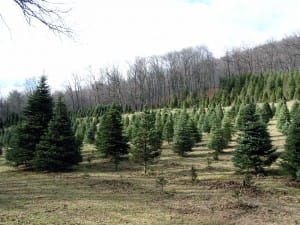Source(s): Gary R Peiffer
Determine where in your home you will display your tree so that you will know at the tree lot what size and shape you need.
Do a freshness test. Hold a branch about 6 inches from the tip. Pull your hand toward the tip, allowing the branch to slip through your fingers. Very few green needles should come off in your hand if the tree is fresh.
Another freshness test: lift the tree a couple of inches off the ground, then bring it down abruptly on the stump end. The outside, green needles should not fall off in substantial numbers. Remember, inside needles do turn brown and shed naturally every year.
A good fragrance and green color also indicate freshness.
CUT TREE CARE
Bring several plastic garbage bags or a large sheet of plastic when you go to purchase your tree. Wrap the tree with plastic if you plan to transport it on top of your car. Cold winter air at 60 mph will dry the tree further and can cause early needle drop.
The most important thing to remember is that real trees need water. Research has not shown much benefit from using “freshness extender” chemicals. They seem to work well for flowers but results are more uncertain for trees.
Make a fresh cut across the base of the trunk, 1/4″ up from the original cut.
When a tree is first cut, a seal of sap occurs naturally over its stump, which keeps moisture in the tree. It’s important to break that seal to allow the tree to take up the water needed to keep it fresh throughout the holidays.
Until you are ready to decorate, keep your tree outdoors, standing in a bucket of water and protected from the wind and sun. This will help the tree retain its moisture.
Keep plenty of water in your stand. A Christmas tree may absorb a gallon of water in the first 24 hours it’s up and two pints to a gallon of water a day thereafter. Check the stand daily and supply fresh water as needed. Never let your tree stand go dry. If the water supply runs out, a seal will form on the cut surface of the tree trunk and a new cut should be made.
Position your tree away from heat sources such as fireplaces, radiators and television sets.
Test your light cords and connections before hanging them on the tree to make sure they are in good working condition. Look for cracked insulation or broken sockets, and make sure all the sockets are filled. Don’t forget to unplug the lights when you go to bed or leave home.
LIVE CHRISTMAS TREES
Several kinds of evergreen trees can be bought as live Christmas trees and then planted after the holidays. It is important to remember that live trees take much more care than cut trees. Live trees should be kept inside no more than two weeks.
LIVE TREES FOR THE ATLANTA AREA
White pine
Leyland Cypress
Virginia pine
Canadian Hemlock
Note: Fir and spruce trees have difficulty surviving hot Atlanta summers. They are not recommended for planting in this area.
HOW TO CARE FOR LIVE TREES
Leave outdoors in a shady spot until mid December. Spray with an anti-transpirant such as Cloud Cover or Wilt Pruf.
Transport indoors on December 15. A child’s wagon, lined with plastic, makes a good cart. The tree can be left in the wagon or it can be set into a wide, shallow pan indoors.
Water the root ball every day. Use at least two quarts of water each time. Pour the water slowly on top of the root ball and allow it to soak in. Do not just pour water into the pan.
Close all hot air vents near the tree. Try to keep the room cool for most of each day. Close all hot air vents near the tree. Try to keep the room cool for most of each day.
Move tree outdoors by December 28. Dig a hole five feet wide and 12 inches deep. Plant the root ball in the center. Apply lots of water. Mulch with three inches of pine straw.
Water weekly until spring. Fertilize with liquid plant food (MiracleGro, Peters, etc.) in mid-summer.
The mention of brand names in this publication does not imply endorsement or exclusion by the Cooperative Extension Service.
RECYCLING TREES
Place your tree in a garden or backyard for use as a winter bird feeder and shelter. Orange slices, bread and suet will attract birds and brighten up the winter landscape.
Christmas trees are biodegradable. The branches and trunk may be removed and chipped to be used as mulch in your garden. Contact your local Clean and Beautiful office for recycling sites.
4 Branch tips and needles provide aromatic stuffing for sachet.
Sunk into private fish ponds or lakes, trees make excellent refuge and feeding areas for fish.
Living Christmas trees can be planted in the yard and enjoyed for years to come. If there is no room in the home landscape, trees can be planted at schools, churches or neighborhood beauty spots.
SOURCES OF TREES
All Local Nurseries
Send self-addressed, stamped envelope to:
Georgia Christmas Tree Association
Cut Tree Guide & Farm List
Route 2, Box 104
Midway, Georgia 31320
Farmers & Consumers Market Bulletin
Thanksgiving week issue
Call 404/656-3645 or 1-800-282-5852
- Carrying and Transporting Chainsaws - October 18, 2016
- How To Prepare Samples For Handling - September 24, 2013
- Identification and Prevention of Termite Problems - September 24, 2013
